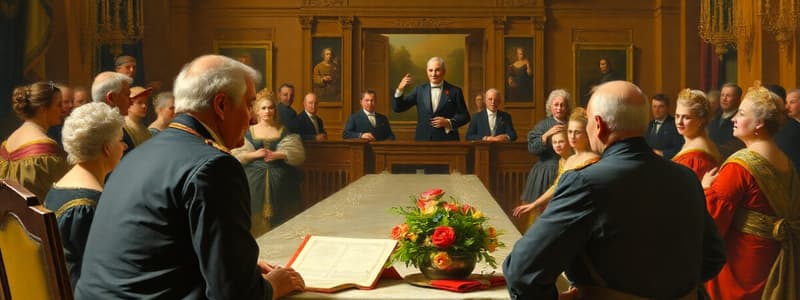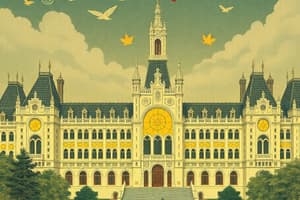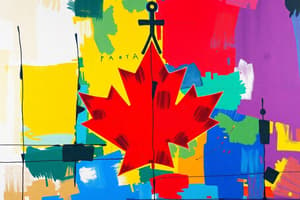Podcast
Questions and Answers
What role does the Governor General play in Canada's government?
What role does the Governor General play in Canada's government?
- Acts solely on the advice of the Queen
- Assembles the Parliament without the Prime Minister’s advice
- Has no power during emergencies
- Acts on the advice of the Prime Minister and government (correct)
Which statement accurately describes the relationship between the Prime Minister and the Cabinet?
Which statement accurately describes the relationship between the Prime Minister and the Cabinet?
- All ministers must be senators before joining the Cabinet
- Cabinet members cannot be changed once appointed by the Prime Minister
- Cabinet members are selected solely by Parliament
- The Prime Minister has the authority to replace ministers at any time (correct)
What is one of the responsibilities of the Governor General?
What is one of the responsibilities of the Governor General?
- Elected member of Parliament
- Delivers the Speech from the Throne (correct)
- Directly manages the Canadian armed forces
- Proposes new laws to Parliament
In what form of government does Canada's head of state hold a constitutional role?
In what form of government does Canada's head of state hold a constitutional role?
Who ultimately holds the power to run Canada according to the Constitution?
Who ultimately holds the power to run Canada according to the Constitution?
What action can the Governor General take in relation to Parliament?
What action can the Governor General take in relation to Parliament?
Which of the following is a characteristic of the role of the Prime Minister?
Which of the following is a characteristic of the role of the Prime Minister?
What is the significance of the phrase 'no one is above the law' in the context of Canadian governance?
What is the significance of the phrase 'no one is above the law' in the context of Canadian governance?
What is required for the Government of Canada to maintain its power?
What is required for the Government of Canada to maintain its power?
What happens when a government loses a vote of non-confidence?
What happens when a government loses a vote of non-confidence?
Which role does the party whip play in Parliament?
Which role does the party whip play in Parliament?
What is unique about the Senate compared to the House of Commons?
What is unique about the Senate compared to the House of Commons?
At which stage of the legislative process can amendments to a bill be made by all members?
At which stage of the legislative process can amendments to a bill be made by all members?
What is a primary reason for having a Senate in Canada?
What is a primary reason for having a Senate in Canada?
What is the maximum number of Members of Parliament in the House of Commons?
What is the maximum number of Members of Parliament in the House of Commons?
Which of the following is a power unique to the federal government?
Which of the following is a power unique to the federal government?
What is the purpose of equalization payments from the federal government?
What is the purpose of equalization payments from the federal government?
What term describes the sharing of powers between different levels of government in Canada?
What term describes the sharing of powers between different levels of government in Canada?
Which stage follows after the 2nd Reading of a bill?
Which stage follows after the 2nd Reading of a bill?
Why might a minority government need to form a coalition?
Why might a minority government need to form a coalition?
Which of the following can the Senate not do?
Which of the following can the Senate not do?
Flashcards
Canadian Parliament Rule of Law
Canadian Parliament Rule of Law
No one, including the Prime Minister, is above the law.
Constitutional Monarchy
Constitutional Monarchy
Canada's head of state is the British Monarch, represented by the Governor General, whose power is limited by the constitution.
Governor General's Role
Governor General's Role
Acts on Prime Minister's advice but can offer advice, encouragement, and warnings.
Executive Branch
Executive Branch
Signup and view all the flashcards
Prime Minister's job
Prime Minister's job
Signup and view all the flashcards
Cabinet
Cabinet
Signup and view all the flashcards
Minister Responsibilities
Minister Responsibilities
Signup and view all the flashcards
Governor General's Special Powers
Governor General's Special Powers
Signup and view all the flashcards
House of Commons
House of Commons
Signup and view all the flashcards
Member of Parliament (MP)
Member of Parliament (MP)
Signup and view all the flashcards
Confidence of the House
Confidence of the House
Signup and view all the flashcards
Vote of Non-Confidence
Vote of Non-Confidence
Signup and view all the flashcards
Party Discipline
Party Discipline
Signup and view all the flashcards
Majority Government
Majority Government
Signup and view all the flashcards
Minority Government
Minority Government
Signup and view all the flashcards
Bill
Bill
Signup and view all the flashcards
First Reading
First Reading
Signup and view all the flashcards
Second Reading
Second Reading
Signup and view all the flashcards
Senate
Senate
Signup and view all the flashcards
Federalism
Federalism
Signup and view all the flashcards
Division of Powers
Division of Powers
Signup and view all the flashcards
Study Notes
Canadian Parliament Structure
- Rule of Law: No one is above the law, including the Prime Minister.
- Constitutional Monarchy: Canada's head of state is the Queen of England, represented by the Governor General. The head of state is not more powerful than the constitution.
- Governor General: Acts on the Prime Minister's advice, but can advise, encourage, and warn. Has emergency powers. Swears in the Prime Minister, Chief Justice, and cabinet ministers. Summons, prorogues, and dissolves Parliament. Delivers the Speech from the Throne, and gives Royal Assent to acts of Parliament. Signs official documents and regularly meets with the Prime Minister. Represents Canada abroad, receives dignitaries, and presents awards. Commander-in-chief of the Canadian Armed Forces.
Executive Branch
- Composed of the Queen, Governor General, Prime Minister, and Cabinet.
- The Prime Minister appoints Cabinet members, and members can be replaced. Usually Cabinet members are elected Members of Parliament.
- Cabinet manages government departments and is responsible for putting laws into place.
- The Prime Minister determines each minister's responsibilities.
- Cabinet resigns when the Prime Minister resigns.
Legislative Branch - House of Commons
- Members are elected by Canadian citizens.
- 338 seats, representing all Canadians.
- Confidence Principle: Government requires the confidence of a majority of MPs to govern.
- Laws, budgets, and policies require a majority vote to pass.
- Political parties have party whips to ensure party discipline.
- Majority Government: 50% + seats
- Minority Government: Less than 50% seats, usually forms coalitions.
- Vote of Non-Confidence: If a minority government loses the confidence of the majority, they resign, and an election is called.
Legislative Branch - The Senate
- Canada's second legislative house.
- Senators are appointed by the Prime Minister, not elected.
- Cannot introduce money bills.
- Purpose: Provides "sober second thought" on bills passed by the House of Commons to ensure they are in the best interest of Canadians.
- Accountability issue: Senators are not elected and therefore not as accountable to citizens as MPs.
Parliament Procedure
- Bill Process:
- First Reading: Bill is read and printed, no debate.
- Second Reading: Members debate the bill's idea and its impact on Canadians.
- Committee Stage: Committee members study the bill, gather information, and suggest changes.
- Report Stage: Committee presents the bill to the House, allowing everyone to debate and suggest changes.
- Third Reading: Members debate and vote on the revised bill.
- Senate: Bills follow a similar process in the Senate.
- Royal Assent: Once passed in both Houses, the bill receives Royal Assent and becomes law.
Federalism
- Canada is a federal system, with different levels of government (federal, provincial, municipal).
- Federalism is needed given Canada's large geography.
- Division of Powers: Federal, provincial, and municipal governments have differing responsibilities.
- Federal Powers:*
- National Defence
- Foreign Affairs
- Employment Insurance
- Banking
- Federal Taxes
- Post Office
- Fisheries
- Shipping, Railways, Telephones, Pipelines
- Indigenous lands and rights
- Criminal Law
- Equalization Payments: Attempts to create similar health, education, and welfare standards in all provinces.
- Provincial Powers:*
- Direct Taxes
- Hospitals
- Prisons
- Education
- Marriage
- Property and civil rights
- Health care
- Shared Powers:* (with federal)
- Agriculture and Immigration.
- Municipal Powers:*
- Very local issues
- By-laws
- Local emergencies
- Animal control
- Road maintenance
Studying That Suits You
Use AI to generate personalized quizzes and flashcards to suit your learning preferences.




